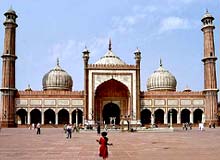Jama Masjid information
Buy a ticket at the entrance to climb 121 steps up the narrow southern minaret (notices say that unaccompanied women are not permitted, but they may be allowed up with a ‘guide’ who’ll expect a tip). From the top of the minaret, you can see one of the features that architect Edwin Lutyens incorporated into his design of New Delhi – the Jama Masjid, Connaught Place and Sansad Bhavan (Parliament House) are in a direct line.
Visitors should remove their shoes at the top of the stairs. There’s no charge to enter the mosque, but you’ll have to pay the camera charge whether you want to use your camera or not. Once you buy a camera ticket, you should be allowed to go out and re-enter later that day if youcorrectiod more: http://www.lonelyplanet.com/india/delhi/sights/religious/jama-masjid#ixzz3jL0emke1


 Jama Masjid of Delhi is the largest mosque in India. The Jama Masjid stands across the road in front of the Red Fort. Built between 1644 and 1658, Jama Masjid is one of the last architectural works of the Mughal emperor Shah Jahan. The spacious courtyard of the Jama Masjid holds thousands of faithful. Jama Masjid is located on a mound in the heart of the old city and projects beautifully into the Old-Delhi skyline. Jama Masjid Mosque was built in red sandstone and marble by more than 5000 artisans. Originally called the Masjid-i-Jahan-Numa, or "mosque commanding view of the world", the Jama Masjid stands at the center of the erstwhile capital city of the Mughals, Shahjahanbad.
Jama Masjid of Delhi is the largest mosque in India. The Jama Masjid stands across the road in front of the Red Fort. Built between 1644 and 1658, Jama Masjid is one of the last architectural works of the Mughal emperor Shah Jahan. The spacious courtyard of the Jama Masjid holds thousands of faithful. Jama Masjid is located on a mound in the heart of the old city and projects beautifully into the Old-Delhi skyline. Jama Masjid Mosque was built in red sandstone and marble by more than 5000 artisans. Originally called the Masjid-i-Jahan-Numa, or "mosque commanding view of the world", the Jama Masjid stands at the center of the erstwhile capital city of the Mughals, Shahjahanbad.
No comments:
Post a Comment